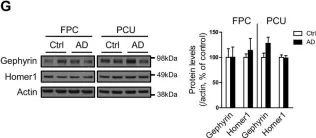Memory loss in Alzheimer's disease (AD) is attributed to pervasive weakening and loss of synapses. Here, we present findings supporting a special role for excitatory synapses connecting pyramidal neurons of the hippocampus and cortex with fast-spiking parvalbumin (PV) interneurons that control network excitability and rhythmicity. Excitatory synapses on PV interneurons are dependent on the AMPA receptor subunit GluA4, which is regulated by presynaptic expression of the synaptogenic immediate early gene NPTX2 by pyramidal neurons. In a mouse model of AD amyloidosis, Nptx2-/- results in reduced GluA4 expression, disrupted rhythmicity, and increased pyramidal neuron excitability. Postmortem human AD cortex shows profound reductions of NPTX2 and coordinate reductions of GluA4. NPTX2 in human CSF is reduced in subjects with AD and shows robust correlations with cognitive performance and hippocampal volume. These findings implicate failure of adaptive control of pyramidal neuron-PV circuits as a pathophysiological mechanism contributing to cognitive failure in AD.
Product Citations: 6
NPTX2 and cognitive dysfunction in Alzheimer's Disease.
In eLife on 23 March 2017 by Xiao, M. F., Xu, D., et al.
-
WB
-
Mus musculus (House mouse)
-
Neuroscience
In The Journal of Cell Biology on 24 October 2016 by Cai, Y., Yang, L., et al.
Our findings suggest that morphine dysregulates synaptic balance in the hippocampus, a key center for learning and memory, via a novel signaling pathway involving reactive oxygen species (ROS), endoplasmic reticulum (ER) stress, and autophagy. We demonstrate in this study that exposure of morphine to hippocampal neurons leads to a reduction in excitatory synapse densities with a concomitant enhancement of inhibitory synapse densities via activation of the μ opioid receptor. Furthermore, these effects of morphine are mediated by up-regulation of intracellular ROS from NADPH oxidase, leading, in turn, to sequential induction of ER stress and autophagy. The detrimental effects of morphine on synaptic densities were shown to be reversed by platelet-derived growth factor (PDGF), a pleiotropic growth factor that has been implicated in neuroprotection. These results identify a novel cellular mechanism involved in morphine-mediated synaptic alterations with implications for therapeutic interventions by PDGF.
© 2016 Cai et al.
-
WB
-
Cell Biology
In Neuropharmacology on 1 June 2016 by Bohnsack, J. P., Carlson, S. L., et al.
The GABAA α4 subunit exists in two distinct populations of GABAA receptors. Synaptic GABAA α4 receptors are localized at the synapse and mediate phasic inhibitory neurotransmission, while extrasynaptic GABAA receptors are located outside of the synapse and mediate tonic inhibitory transmission. These receptors have distinct pharmacological and biophysical properties that contribute to interest in how these different subtypes are regulated under physiological and pathological states. We utilized subcellular fractionation procedures to separate these populations of receptors in order to investigate their regulation by protein kinases in cortical cultured neurons. Protein kinase A (PKA) activation decreases synaptic α4 expression while protein kinase C (PKC) activation increases α4 subunit expression, and these effects are associated with increased β3 S408/409 or γ2 S327 phosphorylation respectively. In contrast, PKA activation increases extrasynaptic α4 and δ subunit expression, while PKC activation has no effect. Our findings suggest synaptic and extrasynaptic GABAA α4 subunit expression can be modulated by PKA to inform the development of more specific therapeutics for neurological diseases that involve deficits in GABAergic transmission.
Copyright © 2016 Elsevier Ltd. All rights reserved.
-
WB
-
Rattus norvegicus (Rat)
-
Neuroscience
Argonaute2 mediates compensatory expansion of the pancreatic β cell.
In Cell Metabolism on 7 January 2014 by Tattikota, S. G., Rathjen, T., et al.
Pancreatic β cells adapt to compensate for increased metabolic demand during insulin resistance. Although the microRNA pathway has an essential role in β cell proliferation, the extent of its contribution is unclear. Here, we report that miR-184 is silenced in the pancreatic islets of insulin-resistant mouse models and type 2 diabetic human subjects. Reduction of miR-184 promotes the expression of its target Argonaute2 (Ago2), a component of the microRNA-induced silencing complex. Moreover, restoration of miR-184 in leptin-deficient ob/ob mice decreased Ago2 and prevented compensatory β cell expansion. Loss of Ago2 during insulin resistance blocked β cell growth and relieved the regulation of miR-375-targeted genes, including the growth suppressor Cadm1. Lastly, administration of a ketogenic diet to ob/ob mice rescued insulin sensitivity and miR-184 expression and restored Ago2 and β cell mass. This study identifies the targeting of Ago2 by miR-184 as an essential component of the compensatory response to regulate proliferation according to insulin sensitivity.
Copyright © 2014 Elsevier Inc. All rights reserved.
-
IP
-
Mus musculus (House mouse)
-
Biochemistry and Molecular biology
Abnormal gephyrin immunoreactivity associated with Alzheimer disease pathologic changes.
In Journal of Neuropathology and Experimental Neurology on 1 November 2013 by Hales, C. M., Rees, H., et al.
Many neurodegenerative disorders involve the abnormal accumulation of proteins. In addition to the pathologic hallmarks of neurofibrillary tangles and β-amyloid plaques in Alzheimer disease (AD), here we show that abnormal accumulations of gephyrin, an inhibitory receptor-anchoring protein, are highly correlated with the neuropathologic diagnosis of AD in 17 AD versus 14 control cases. Furthermore, gephyrin accumulations were specific for AD and not seen in normal controls or other neurodegenerative diseases including Parkinson disease, corticobasal degeneration, and frontotemporal degeneration. Gephyrin accumulations in AD overlapped with β-amyloid plaques and, more rarely, neurofibrillary tangles. Biochemical and proteomic studies of AD and control brain samples suggested alterations in gephyrin solubility and reveal elevated levels of gephyrin lower-molecular-weight species in the AD insoluble fraction. Because gephyrin is involved in synaptic organization and synaptic dysfunction is an early event in AD, these findings point to its possible role in the pathogenesis of AD.
-
Homo sapiens (Human)
-
Neuroscience
In Elife on 23 March 2017 by Xiao, M. F., Xu, D., et al.
Fig.2.G

-
WB
-
Collected and cropped from Elife by CiteAb, provided under a CC-BY license
Image 1 of 1
